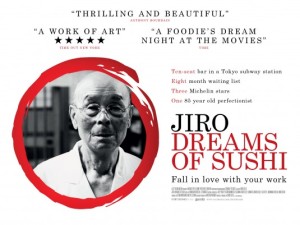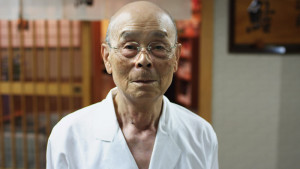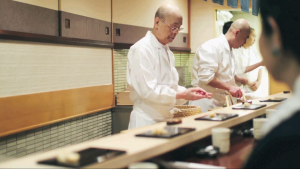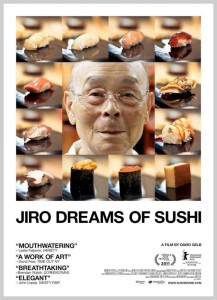Jiro Dreams of Sushi opens with a literal explanation of the films’ title: the eponymous sushi chef details how he would indeed literally dream of sushi and wake with a burst of creativity concerning his culinary craft. Over the course of the documentary, this all-consuming creative obsession of Jiro’s mind to innovate and perfect his technique becomes the prism through which the film’s explores larger ideas of creativity, discipline, and legacy.
The beginning lures the viewer in with hints toward Jiro’s legendary fame—a montage of his various awards, including the three-star Michelin rating—juxtaposed against tales of his incredibly idiosyncratic work ethic: a man that repeats his daily habits with religious discipline, unwavering in his routines, bound by some deeply embedded personal code. A prominent food critic can hardly contain himself when effusing over Jiro’s sushi: explaining that no other restaurant in Japan contains those components that make Jiro’s so celebrated: a minimalist menu, creativity, and consistency.
Eventually, hints toward the origin of this documentary’s mysterious subject are revealed: his parents were brutally harsh, deeply flawed, and undeniably responsible for the psychological impulses that so intensely motivate him to the present day. Though Jiro speaks about a constant love of his work, and how this commitment has blossomed his life into one of honor and fulfillment, he also hints toward the darkness of his past that has molded this current lifestyle. At the age of nine, his parents bluntly explained that he had, “No home to come back to”—equating success to life and failure to death. Additionally, Jiro watched as his father—an alcoholic that made his living carting people on a ferry—wasted his potential and so severely devastated the young boy. Though his philosophy may appear harsh compared to popular Western parenting philosophies, he has impressed this unforgiving discipline upon his sons, as well, which has resulted in their undeniably successful careers.
Nonetheless, his initial upbringing sheds further light on these developments in craft. Jiro recounts how difficult working as an apprentice could be—with a boss that would abuse and overwork him—but to whom he remained loyal and mastered his burgeoning skills. As the obsession consumed him, Jiro innovated various methods of preparation and design that elevated his sushi far above his peers. More interesting than these techniques, however, is found in Jiro’s regimen for focusing on improvement.
With almost zero variation in his daily habits, Jiro resembles something closer to a machine than a human being in his singular drive to maintain consistency. Whether for a funeral or awards ceremony, Jiro insists on returning to the modest kitchen and not allowing these emotions to distract from his daily output. And more importantly, despite financial success and critical acclaim, Jiro refuses to remain satisfied. Constantly, he seeks to improve and elevate his techniques in all areas: seating arrangement, food preparation, food source—that harmonize in their excellence to create this overwhelmingly experience for the customer.
Moving forward, the focus of the documentary shifts from Jiro to his two sons, most notably: Yoshikazu. While the younger brother left to open his own sushi restaurant under the family name—instructed with the same warning that he had nothing to come back if it failed (and leading to subsequent success)—Yoshikazu works with his legendary father on a daily basis and negotiates with both recognizing his own triumphs and the importance of carrying forward his father’s inimitable legacy into the future.
Though Jiro remains the most prominent figure credited with creating this remarkable sushi, Yoshikazu and the other chefs work with a similarly astounding devotion to their job. Yoshikazu explains that new employees are first tasked with wringing out a hot towel, and until they are able to successfully accomplish this menial task up to their standards, that they are then promoted to working in the kitchen.
This will often take years.
After, they are then promoted to working in the kitchen, where again, they must hone their skills to the point of perfection. Much of what drives their work ethic and fulfillment seems to be in pleasing Jiro himself—one chef admits that he cried after Jiro finally considered one of his dishes acceptable after hundreds of dismissals.
One quickly realizes that this aspect—of ensuring every step of the process meets the same high quality standard as every other component—attributes to the overall exemplary quality of Jiro’s work. The film detours a bit to show the selection of the fish process, and how Jiro or his son seek the best fish possible without substitute. Or, more often, the dealers will reserve their best quality fish especially for Jiro—as they want their product to be put to the best use possible. Additionally, the film sidetracks to explain how the best fish can often be hard to find in this day and age, due to overfishing and overconsumption of sushi as a delicacy. Jiro and Yoshikazu both implore that the sacrifice of natural resources for food consumption cannot continue, though the film then returns to the subject of its title for its conclusion.
Having achieved so much acclaim and fulfillment in these later years, Jiro reflects on his past as an adolescent troublemaker, and many friends chime in that they remember him as a vicious bully. Jiro seems to recognize the redemptive quality to his story—that he began life as such a wayward youth only to have his all-consuming obsession provide a center of focus for his emotions and effort. The film also juxtaposes such an idea against the legacy that his sons struggle to negotiate in considering their own legacy. For although the Michelin judge awarded Jiro—and he accepted the prize—for serving such excellent sushi that meets their rigorous qualifications, it is revealed that Yoshikazu—his son—served the sushi that day.
Like its subject, the film works best when centering its focus upon Jiro to explore the various aspects that overlap with the most curious qualities contained within the renowned chef’s mentality: self-discipline, creativity, focus, and consistency. Near the end, one cannot help but be astonished by Jiro’s resolve and commitment. A man refusing to settle for less, refusing to compromise to his physical decline, refusing to wallow in his successes—and who continues to push himself forward for the betterment of himself, his craft, and those customers that he serves. For a film with a number of profound and provocative ideas at its epicenter, it is the study of this single man—one whose work and philosophy will continue to be spread through his sons and those influenced by the documentary itself—that one begins to understand the significance of a great piece of sushi.




Pingback: Witness the Art of Sushi by Japanese Chef Jiro Ono in This Documentary | Japan Info